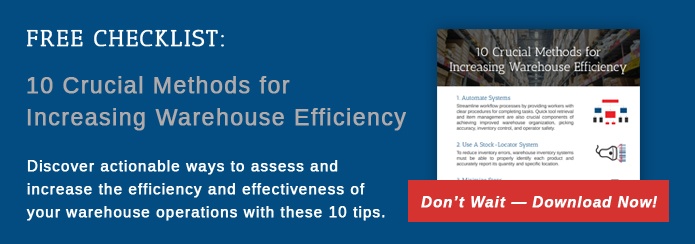 No company that sells products ever really wants to issue refunds or see items returned. Still, returns are a reality for companies who want to please their customers. Whether it's products that don't work as expected, aren't the right size or color, or perhaps because of simple buyers' remorse, there are endless reasons customers choose to return products for exchanges and refunds.
No company that sells products ever really wants to issue refunds or see items returned. Still, returns are a reality for companies who want to please their customers. Whether it's products that don't work as expected, aren't the right size or color, or perhaps because of simple buyers' remorse, there are endless reasons customers choose to return products for exchanges and refunds.
While sales teams and others may play small parts in processing returns (such as handling the initial complaint or authorizing the shipments of returned products), it's usually the warehouse that must deal with the returned items, so let's take a look at the challenges that RMAs (Return Merchandise Authorization) pose to warehouse operations.
Common RMA Scenarios
In a retail environment, like your local Walmart, the return process is fairly straightforward. Generally speaking, the customer walks in, transacts the exchange or refund and then leaves. The retailer then restocks the returned goods or sends them back to the warehouse for final disposition. With B2B or online sales, though, the return process is usually much more complicated.
RMAs arrive at the dock for many different reasons. Depending on what the particular reason is, the goods may need to be re-stocked, repackaged, inspected, repaired, refurbished, returned to the manufacturer or discarded. Additionally, goods have to be matched with the actual RMA authorizations so that customers can receive refunds or credits as appropriate. In some cases, there may be no authorization at all for the returned goods in question, which results in even more investigation being required.
If your company handles very few returns, then this probably isn't a big deal. If your warehouse or distribution center sees many returned products come through the door, though, then it's easy to see how RMAs can spiral out of control quickly without adequate oversight and management.
Creating an RMA Plan
Given all of the variables that can come into play, it is important to plot out what your RMA process should look like for each scenario. The first step is assigning responsibility for issuing authorizations for returns.
Once you've decided who will receive requests for returns and issue the authorizations, you'll need to develop a process for managing each type of RMA once it arrives at your warehouse. As there are many reasons why a customer might choose to return a product, there are many routes an RMA package might take once you receive it.
Let's look at a very simple RMA. Your company, for whatever reason, shipped the wrong product to a customer. The customer recognized this immediately and simply refused the shipment from the carrier. In this case, there is nothing wrong with the product, so it can be returned to inventory immediately. Ideally, the RMA authorization should not only include the authorization number but must also note that the product in question can be returned to inventory without having to go through inspection or be routed to a repair/refurbishing department. The flow for this type of RMA is very straightforward—it goes straight to putaway from receiving.
Of course, other RMA scenarios might be a bit more complex. If the customer returns a product because it doesn't work as expected or is defective, the item may need to be inspected, routed for repair or refurbishing, returned to the original manufacturer, or discarded, depending on your company's policies. One important thing to note here is that RMAs should always include the reason for the return so that the warehouse can route returned goods quickly and efficiently.
Failure to provide adequate RMA data to the warehouse can have some costly consequences. In many companies, RMAs are received by dock personnel and then placed in a "dead zone" where they remain for long periods—or worse, are completely forgotten. When this happens, it's usually because no one knows why the product was returned or what to do with it. A simple note such as "customer claims defective" or "ordered in error—restock" can do wonders in boosting the efficiency of managing returns once they hit the warehouse.
Finally, designate an area for products returned without valid RMAs or other nonconforming goods, and check the contents located there on a regular basis. This will ensure that the products can be processed quickly and efficiently and that the customers who returned them are made whole as soon as possible.
The Right WMS Can Help Ease RMA Pain
RMAs are hard to handle for distribution centers and warehouses because they're just so backward. Using the right warehouse management system (WMS) to handle and route returns can help reduce the pain associated with RMAs considerably.
The WMS should be able to do all of the necessary routing to ensure that returned goods get to where they need to go (i.e. returned to stock as resaleable new inventory, inspected, repackaged, refurbished to be sold at discount, or discarded and written off). The WMS should also be able to provide alerts to people who are involved in the RMA process as well as communicate with the ERP so that refunds or credits can be generated.
For instance, if a product was returned and tagged as "defective" or something similar, the WMS should automatically send a notification to whoever is in charge of handling the inspection and disposition of items thought to be defective. Of course, a robust WMS will be able to route RMA goods or send notifications based on any number of parameters or variables your company defines.
On the surface, simple return routing and tagging may seem trivial or insignificant. However, creating and implementing such rules are not small tasks. Therefore, a WMS that provides such features can help considerably in preventing returns from falling through the cracks in your logistics process. This in return reduces losses, and more importantly, helps you resolve returns faster and more efficiently for your customers.




